Bio Breathing Project
Bio Breathing Project
Designers
- Anna Nikaki
- Pedro Sodre
- Lauren Chun
- Addison Worthington
Project Description
Bio Breathing is a wall installation, designed to be experienced by two participants facing opposite sides of the wooden wall. They are encouraged to breath in and out while wearing a belt that is transforming their breathing status into vibrations. Participants are trying to experience each other’s breath by the vibrations produced while feeling the different textures and materials that are mounted on the wall. LED lights are also changing according to the exhale and the inhale of the participants.
Video Link (google drive link) (Demo)
Project summary
One of the most remarkable aspects of Mycelium is the way in which
it is integrated and communicates across distance like a network. In this installation we create a divided space, in which two users are separated by a mycelium surface. We generate low frequency drones using the electrical fluctuation of the mycelium as it grows and then convert the grown mycelium into the bio material patches that constitute the two sides of the wall.
We invite the audience to become part of mycelium structures by wearing a belt and touching their sides of the mycelium wall. The belt is equipped with a breath monitoring sensor. The movement of the user’s breath modulates the mycelium-generated music and light on the other of the wall – creating sound, vibrations (that the other user can feel by touching the wall) and visual stimuli that users can feel and respond to with their breathing, linking them through interaction.
Weekly Updates
10/27/22
Observation & IdeatioN
11/03/22
RAPID PROTOTYPING
Bio Breathing Rapid Prototype
Rapid Prototype Video
We created two separate rapid prototypes.
Prototype 1: Breathing Belt Visualization
Answering the questions:
What might the scale of each component might be to each other?
How does the breathing belt affect the visuals and vibrations from the wall?
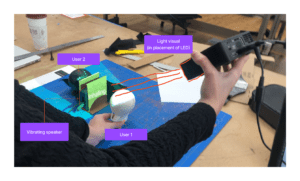
Prototype 2: Speakers against cardboard
Answering the Questions:
How does the vibrations feel through cardboard?
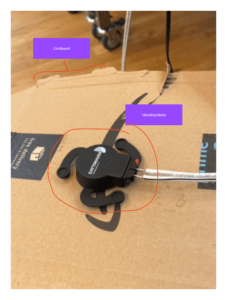
Visual Prototypes
Wall with Bio material panels on it with fabric above.
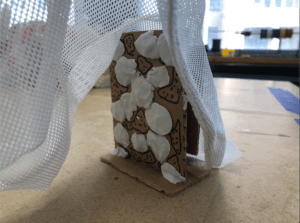
Bio Material Status

Reishi Mushroom Culture
Questions:
- Could a blind person use and understand my project?
Yes, and sort of. They would need assistance putting on the belt. They would miss the lights, but they would understand the vibrations they feel and the bio material.
2. Could a Deaf person use and understand my project?
Yes, they could feel the vibrations, put the belt on, see the lights.
3. Could a Deafblind person use and understand my project?
Yes, but they would need help putting the belt on.
11/10/22
USER FEEDBACK
User Testing Script
User Testing Script (google doc)
Analysis/TakeAways
- Our users were confused with the different color lights being inhale and exhale for breathing.
- The belt was difficult to have people wear in the position we asked in the script. Also the initial script needed rephrasing.
- Users enjoyed feeling the vibration from the other side of the wall and the intimacy they had.
- Users were more engaged than they expected.
11/17/22
ITERATION
Materials
| Electronics | Material |
Belt
Wall
|
Belt
Wall
|
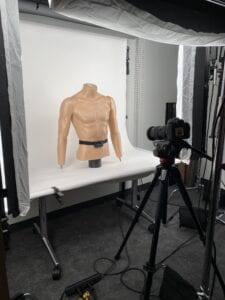
5 W’s Chart
Source: Velasco, Carlos and Marianna Obrist. Multisensory Experiences. 2020.
| Components | Questions and considerations |
| Background (Why) | We want to design the relaxation space to allow people to have a break from their stresses. Bring people together to experience synchronized breathing. |
| Impressions (What) | We want users to feel like they are experiencing meditative connection, and explore the touch of bio materials. Connection between people who may either know each other or complete strangers. |
| Events (When) | The user starts by walking up to a wall and noticing their breathing, putting on a belt. Second, they breathe in and out, hold it and press the start button. Third, they wait till the facilitator says to breathe in and notice the wall in front of them. Fourth, the user touches the wall and feels the panels, they feel the vibrations of the wall as they breathe in and out. At the same time, the user notices the light reacting to their breathing. |
| Sensory Elements (How) | We selected audio, tactile, visual, and olfactory. We invite people to touch and listen and watch their breathing.
Visual – lighting Audio – the vibration hearing it Tactile – the vibration, clay and burlap Proprioception – feeling of the belt breathing again your body |
| Receiver (Who) | There are 2 participants. We are taking a universal design approach. We want to design for the general population of ITP and the community. |
System Diagram
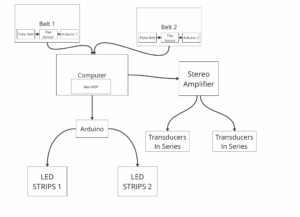
Code
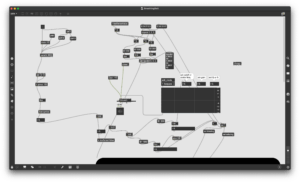
Timeline
- 10/27/2022: Milestone 1 Research/Inspiration
- 11/04/2022: Milestone 2 Rapid Prototype
- 11/10/2022: Milestone 3 User Testing
- 11/17/2022: Milestone 4 Building and Documentation
- 11/30/2022: Milestone 5 Building – Assembling
- 12/01/2022: Milestone 6 Presenting the Prototype.
- 12/08/2022: Milestone 7 Final Video
Sources
Miro Board – https://miro.com/app/board/uXjVPKC297k=/
Final Project
Final Deliverables
- Weekly Updates Weekly Update WordPress
- Design Inspiration Video Google Drive
- Prototype Demo Video Google Drive
- Final Presentation Video Google Drive
- Final Presentation Google Slides
- (google drive of all content) https://drive.google.com/drive/folders/1dmy934NKkDN8_2xv-9ISMWYNkEoppEJv